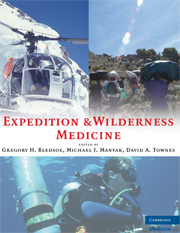Book contents
- Frontmatter
- Contents
- Contributors
- Foreword
- Preface
- Acknowledgments
- PART I EXPEDITION PLANNING
- 1 The Expedition Physician
- 2 Assessing Expedition Medical Needs
- 3 Expedition Medical Kit
- 4 Immunizations
- 5 Legal Considerations during Expedition Planning
- 6 Travel Safety
- 7 Nutritional Support for Expeditions
- 8 Water Treatment
- 9 Special Considerations
- 10 Communications Planning for the Expedition Medical Officer
- 11 Minimizing Risk on an Expedition
- 12 The Expedition Returns
- PART II EXPEDITIONS IN UNIQUE ENVIRONMENTS
- PART III ILLNESS AND INJURIES ON EXPEDITIONS
- APPENDIX The Expedition Medical Kit
- Index
7 - Nutritional Support for Expeditions
from PART I - EXPEDITION PLANNING
Published online by Cambridge University Press: 05 March 2013
- Frontmatter
- Contents
- Contributors
- Foreword
- Preface
- Acknowledgments
- PART I EXPEDITION PLANNING
- 1 The Expedition Physician
- 2 Assessing Expedition Medical Needs
- 3 Expedition Medical Kit
- 4 Immunizations
- 5 Legal Considerations during Expedition Planning
- 6 Travel Safety
- 7 Nutritional Support for Expeditions
- 8 Water Treatment
- 9 Special Considerations
- 10 Communications Planning for the Expedition Medical Officer
- 11 Minimizing Risk on an Expedition
- 12 The Expedition Returns
- PART II EXPEDITIONS IN UNIQUE ENVIRONMENTS
- PART III ILLNESS AND INJURIES ON EXPEDITIONS
- APPENDIX The Expedition Medical Kit
- Index
Summary
INTRODUCTION
Food and Its Role in the History of Exploration
Food has played a prominent role in “expeditions” from the days of early sailing voyages and turn of the century arctic explorations up to the present-day conquest of outer space. Almost every account of exploration expeditions contains descriptions of food (or the lack thereof). In his book Polar Journeys, food scientist Robert Feeney observes that “An adequate supply of food and water has always been the primary need of any group of explorers” (1998). The technology of food packaging, fortification, and preservation has changed dramatically over the past century along with our understanding of nutritional requirements. Man's nutritional requirements, however, are still basically the same as they were years ago, only our understanding of nutrient requirements has changed. Man still requires basically the same amount of protein, vitamins, minerals, and water as did the sailors aboard Christopher Columbus's voyage to the new world in 1492, Robert Peary's conquest of the North Pole in 1909, and Will Steeger's first confirmed dogsled journey to the North Pole (without resupply) in 1986, as well as Tom Avery's retracing of Peary's route to the North Pole in 2005. Nutrition, in particular energy requirements, may be somewhat altered in modern expeditions due to better equipment, more efficient clothing, and, in some cases, motorized conveyances; however, this often simply permits an expedition to push harder and cover more miles in a day.
- Type
- Chapter
- Information
- Expedition and Wilderness Medicine , pp. 83 - 97Publisher: Cambridge University PressPrint publication year: 2008



